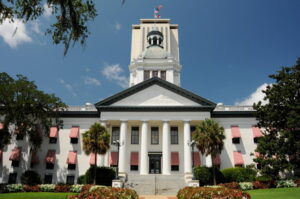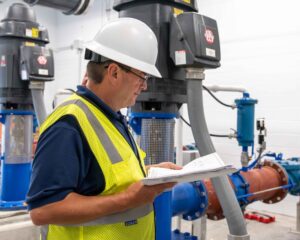
By MARY SZAFRANIEC
Director of Water Quality Initiatives,
Resource Environmental Solutions (RES)

By ANSLEY TILLEY
Director of Alternative Delivery Solutions,
Resource Environmental Solutions (RES)
Florida’s Ecosystem Restoration
As Florida continues to invest in restoring the state’s natural resources, funding gaps persist. A 2023 Florida Economics and Demographic Research (EDR) report estimates $136 billion will be needed to address water resource protection and infrastructure over the next 20 years. A significant portion of that has no identified funding source. This situation underscores the urgency of innovative solutions in Florida’s ecosystem restoration and water management to bridge these substantial funding gaps.
Water management is at the heart of the discussion: Florida is grappling with frequent incidents of “sunny day flooding,” threats of water supply shortages, waterbodies with impaired water quality conditions, and sea level rise and saltwater intrusion impacts on water supplies.
One bright spot for closing the funding gap is the pairing of ecosystem restoration and “nature-based” solutions (NbS), with the alternative procurement tool of Public-Private Partnerships (P3). Many of Florida’s water resource issues can be addressed, at scale and with performance guarantees, by employing the expertise of the private sector to restore nature’s processes to improve resilience for our communities. Stream and floodplain restoration, natural or constructed treatment wetlands, coastline stabilization, and green infrastructure projects are typical NbS projects that help solve water resource challenges and can be efficiently implemented through alternative procurement methods.
Scaling Up with Alternative Project Delivery
Engineers and scientists, alongside federal and state agencies, are making valiant efforts to protect, restore, manage, and sustain ecosystems. However, these efforts have largely been carried out at relatively small scales, sometimes taking decades to deliver under traditional procurement practices and design-bid-build project delivery.
Meanwhile, two major factors are setting the stage for more meaningful, large-scale projects. The first is Florida’s emphasis on ensuring community resilience and protection from sea level rise. The second is anupdate to the state’s stormwater rules to further protect water quality and quantity under the Clean Waterways Act and focus on meeting Total Maximum Daily Loads (TMDs) and Minimum Flows and Levels(MFLs).
Alternative project delivery has evolved in other parts of the nation to successfully support large, impactful ecosystem restoration, often through unique operating models. One example is the turnkey project approach, which begins with data-driven land siting and acquisition and then dovetails into design, permitting, construction, monitoring, and maintenance, ultimately guaranteeing project performance. This approach provides price certainty, expedites the implementation of landscape-scale restoration to achieve ecosystem improvements, and allows private partners to assume the risk of ensuring project success.
Alternative project delivery has started moving the needle on improving water quality, aquifer recharge, flood resilience, and biodiversity in regions of the nation that have embraced this unique and effective project delivery method. Governments benefit from custom solutions with streamlined design and construction, reduced risks, and opportunities for innovation in implementation and funding. Private sector providers with specialized business models can assume the
responsibility to deliver desired project outcomes, including ecological uplift, hydrologic improvements, and adaptive management, all rooted in science-based design, along with long-term stewardship to ensure lasting project success.
The Public-Private Partnership (P3) Process – How it Works
Florida is fortunate to be one of the states where the legislature provided authority and guidance in implementing alternative project delivery. In 2013, the Florida legislature recognized that public resources were inadequate to meet growing capital and operational needs for infrastructure and restoration at scale, and developed 255.065, F.S., which invoked authorities for P3s to meet public needs “by improving the schedule for [project] delivery, lowering the cost, and providing other benefits to the public.”
The private sector, as a partner, can provide local and state governments with additional capacity, specialized expertise, and innovative approaches that can lead to advanced outcomes for natural systems restoration and protection. In addition, private sector partners can provide price certainty and variable payment structures necessary to meet ever-expanding requirements and begin “filling the funding gap” identified by EDR.
Section 255.065, F.S provides public entities with a streamlined, efficient process for implementing P3s while protecting the public interest and ensuring competitive procurement. The statute requires that projects serve a public purpose and lays out the process for ensuring competitive procurement of innovative solutions that may be submitted to a public entity as an unsolicited proposal from the private sector. Upon receipt of the proposal, the public entity may then review, evaluate, and rank the proposal against other proposals that may be received by the public entity for a similar project, after issuing a public notice for a specified period. Following the notice period, the public entity may elect to negotiate a contract with the highest-ranked private entity submitting a qualified proposal.
One of the major draws of the P3-driven alternative project delivery approach is price certainty and the ability to transfer performance risk and liability from the public entity to the private sector project provider. This type of risk and liability transfer is often supported by financial assurances (i.e., financial/performance bonds) to further guarantee project performance, operations, and long-term maintenance through the contract period.
In some instances, across the country, the performance guarantees, price, and liability transfer can last more than 40 years. A recent example of a P3-driven turnkey ecosystem restoration project is Polk County’s Wilson Ranch Reserve. This project improves floodplain performance, reconnecting the Peace River to its early floodplain system through stream restoration, which further improves local hydrologic conditions, water quality, and habitat conditions.
Similar projects forthcoming across the state will demonstrate that P3s are a critical tool for solving Florida’s water challenges. By storing, treating, and recharging more water at scale, these projects inject resiliency and sustainability at every step of the way to help protect and restore Florida’s ecosystems. ●





















